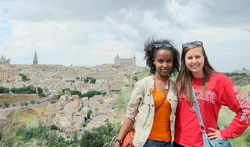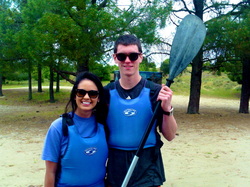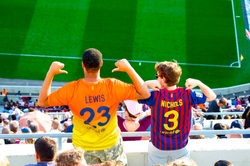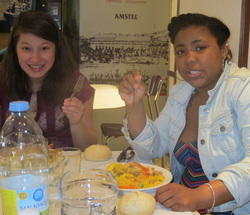 Friday afternoon around 3 pm we left Segovia to embark upon our final excursion to Toledo and Madrid. After a two-hour drive we arrived to the beautiful city of Toledo. Toledo is enclosed by a river called El Río Tajo which is one of the most important rivers in Spain. After checking in the hotel we walked through the city with our professors and learned some of the history of Toledo including the towers constructed by Arabs. After an hour we were had a few hours of free time and we went our separate ways and did a variety of things including visiting a museum, an antique store, and shopping at store filled with American products called a Taste of America. Later that night we dined in the hotel and some of us headed out to experience Toledo at night.
The next morning we got up early to visit one more historic site in Toledo, the extraordinary cathedral. The cathedral in Toledo is one of three Gothic-styled cathedrals and the church was built in the same place a mosque previously stood and inside there the Arabic designs can be seen. The most impressive sight in the cathedral was the retablo which is the decorative piece located behind the altar. The retablo contains series of paintings depicting the life of Christ and in contrast to the cathedral in Salamanca, the retablo are actual wooden sculptures that were painted. After leaving the cathedral we had an hour of free time we headed at restaurant where some of us tried a traditional Spanish meal called calcamuses. After lunch we spent the afternoon in Madrid where we visited El Museo Nacional Centro de Arte Reina Sofía which houses several contemporary art pieces from artists including Pablo Picasso, Ignacio Zuloaga and Juan Gris. After leaving the museum we all decided to eat churros con chocolate for the last time together and afterwards headed back to Segovia for our last few days.
A las tres de la tarde salimos para Toledo y Madrid para nuestra ultima excursión. Después de dos horas llegamos a la ciudad bella de Toledo. La ciudad se encierra por El Rio Tajo, uno de los ríos mas importantes en España. Caminamos por la ciudad para aprender las historia de la ciudad. Despues nos separamos para explorar la ciudad e ir de compras. A la noche cenamos en el hotel y después unos de nosotros fueron para disfrutar la vida de la noche.
La próxima mañana nos despertamos para visitar otro sitio de Toledo, La Catedral. La catedral de Toledo es uno de las tres catedrales del estilo gótico. Antes de la construcción de la catedral había un mezquita que los cristiano destruyeron para construir la catedral. La vista mas preciosa en la catedral fue el retablo con las esculturas de madera de la vida de Jesús Cristo. Luego fuimos al restaurante para comer. Tomamos comidas diferentes incluyendo paella, pisto, macarrones y una comida tradicional que se llamaba calcamuses. Después de comer, fuimos a Madrid para visitar El Museo Nacional Centro de Arte Reina Sofía que contiene obras de Picasso, Zuloaga y Juan Gris. Antes de salir comimos churros con chocolate juntos por la ultima vez y salimos para Segovia.
 Emily McEvoy and Ben Gillespie Thursday, June 6th our group took a trip to Hoces del Duratón Natural Park to go Kayaking. Hoces del Duratón Natural Park is located about an hour bus ride away from Segovia. The name of the park refers to the Duratón River and "Las Hoces" refers to the series of 100m high gorges that were formed by the Duratón and literally translates to “The Scythes” because of the shape of the river. When we first arrived we got suited up in our life jackets then practiced using the oars. Our guide then took us down to the river and we got into our kayaks. The park was beautiful and exploring it in our kayaks was really fun. We got to see huge birds such as the Griffon Vulture and the Egyptian Vulture. Our guide told us that the Griffon Vulture is about 3-4 feet long with a 7–9 foot wingspan. They were amazing creatures to watch fly over the gorges.
After Kayaking through the river for about an hour and a half we left to have lunch in Sepúlveda. On the way to Sepúlveda we stopped at a lookout of the park so we could get some pictures. The view was breathtaking. After eating lunch in Sepúlveda we explored the town for about an hour, enjoyed the views, and bought some ceramics that were made in the town. It was a fun-filled, and very tiring day.
Jueves, 06 de junio nuestro grupo hizo un viaje al Parque Natural Hoces del Duratón en kayak. El Parque Natural Hoces del Duratón se encuentra a una hora de viaje en autobús de Segovia. El nombre del parque se refiere al río Duratón y "Las Hoces" se refiere a la serie de quebradas altas 100m que se formaron por el Duratón y literalmente se traduce como "The Scythes" debido a la forma del río.. Nuestro guía nos llevó después hacia el río y nos metimos en nuestros kayaks. El parque era hermoso y su exploración en nuestros kayaks fue muy divertido. Llegamos a ver grandes aves como el Buitre de Griffon y el Buitre Egipcio. Nuestro guía nos dijo que el Buitre de Griffon es cerca de 3-4 pies de largo con una envergadura de 7-9 pies. Eran criaturas increíbles para ver volar a través de los desfiladeros.
Después de Kayak por el río durante aproximadamente una hora y media nos fuimos a almorzar en Sepúlveda. En el camino a Sepúlveda nos detuvimos en un mirador del parque, así que pudimos tomar algunas fotos. La vista era impresionante. Después de comer el almuerzo en Sepúlveda exploramos la ciudad durante aproximadamente una hora, disfrutamos de las vistas, y compramos algunas cerámicas que se hicieron en la ciudad. Fue un día lleno de diversión y estábamos muy cansados después.
 Today's Bloggers are Jamel Lewis and Sam Nichols
This past weekend we had the pleasure of spending four nights in the incredible Mediterranean city of Barcelona. Encompassing just over 310 sq mi, and being home to 1.62 million inhabitants, Barcelona is the second largest city in Spain and the sixth most populous urban area in the European Union. The city is a major tourist destination for people all over the world with unique attractions such as the architectural works of Antoni Gaudí, open-air markets, designer fashion outlets, a world-class football team, beautiful beaches, and a very energetic nightlife.
Being that it was a truly free weekend we were all able to do as much or as little as we wanted but most of the group opted to do a bit of everything. Everyone managed to see at least one of Gaudí’s architectural masterpieces (Casa Mila, Sagrada Familia, Park Güell, Casa Batlló, etc.), visit at least one of the many beaches around the city, see the la Boqueria market at La Rambla, buy at least one souvenir, witness some of the nightlife, and go to a Barcelona soccer game. Coming from Segovia it was a thrill to experience the modern and vibrant metropolis that is Barcelona and hopefully we will someday have the chance to go back and see the things we may have missed the first time around.
***************************
El fin de semana pasado, nosotros tuvimos el placer de pasar cuatro noches en la bella ciudad mediterránea de Barcelona. Barcelona tiene 1,62 millones de habitantes y también es la segunda ciudad más grande en España y la sexta área urbana más poblada de la Unión Europea. Esta ciudad es un mayor destino turístico para personas de todo el mundo. Hay muchas atracciones únicas como las obras de Antoni Gaudí, mercado al aire libre, tiendas de moda de diseño, un equipo de fútbol de primer nivel, bellas playas, y una vida nocturna muy energética.
Siendo que era un fin de semana libre nosotros podíamos haber hecho tanto o tan poco como queríamos, pero la mayoría del grupo optamos por hacer un poco de todo. Todos nosotros pudimos ver al menos una de las obras maestras arquitectónicas de Gaudí (Casa Mila, Sagrada Familia, Park Güell, Casa Batlló, etc.), visitar algunas de las playas alrededor de Barcelona, ver el mercado de la Boquería en la Rambla, comprar al menos un recuerdo, testigo de algunos de la vida nocturna, e ir a un partido de fútbol de Barcelona. Viniendo de Segovia fue emocionante de experimentar la metrópolis moderna y vibrante que es el Barcelona. Espero que algún día vayamos a tener la oportunidad de volver y ver las cosas que pudimos haber perdido la primera vez.
 Today's blog was written by Victoria Pray and Kiona Deans. *Kiona will probably kill McConnell when she sees this photo so it will be changed later today after we take a new one!
After arriving in Madrid, we headed over to the Royal Palace of Madrid. King Charles III was the first king to live in the palace and he started living there in 1764. The architecture in the palace is Italian and the styles of each room changes with each room but the main styles are baroque and neo-classical. This palace is not just a museum, but royalty (Juan Carlos I and Sofia) come here a couple times a month for either celebration or business. The last king to actually live there year-round was Alfonso XIII and that was in 1931. Some kings collected certain items such as clocks, tapestries, and chandeliers, which shows because there is at least one in almost every room. Some of the rooms have new items such as carpets and drapes but other rooms such as the throne room have not been changed since 1764. The king and queen no longer sit on the thrones because they are now part democratic monarchy and they don’t have absolute power. One room we saw – the dressing room – was completely made of porcelain, which can be taken apart at any moment because the porcelain is screwed into wood. Carlos III apparently had three different porcelain dressing rooms that he kept. In the past, the main dining room table had so many bronze pieces, fruit, and flowers as centerpieces (to show power) that the guests were unable to see each other. Now, however, there is a more modest centerpiece.
Next, we visited the Museo del Prado. Luis mainly showed us paintings from Diego Velázquez and Francisco de Goya. Velázquez was the official painter of the royal family and when they traveled to Italy, he came with them. Because of this, he inspired Italian painters in their style. Goya also painted royalty at first, but after the Napoleonic War, his attitude towards the Spanish government changed, which led to his “pinturas negras” (translated as black paintings). These paintings are much more embittered and bleak with disturbing images such as his famous “Saturn.” After the museum, we went to lunch at the Hotel Mora and did some sightseeing before leaving for Segovia.
En Madrid, el grupo visitó el Palacio Real de Madrid. Carlos III fue el primer rey para vivir en el palacio en 1764. La arquitectura en el palacio es de Italia y los estilos de los cuartos incluyen barroco y neo-clásico. Alfonso XIII fue el ultimo rey para vivir permanente en el palacio, pero Juan Carlos I y Sofía visitan el palacio durante el mes. Unos reyes han coleccionado unas cosas como relojes, tapices, y arañas y cada cuarto tiene al menos uno de cada cosa. El cuarto de trono es el único cuarto que no ha cambiado desde 1764. El rey y la reina no se sientan en los tronos porque ahora, son parte de una monarquía democrática. El vestuario está hecho de porcelana y se puede estar desatornillado de la madera del pared. En el pasado, la central de la mesa tenía muchas piezas de bronce, frutas, y flores que los huéspedes no podían ver el uno al otro pero ahora el mesa tiene una central modesta.
Después del palacio, visitamos el Museo de Prado donde vimos las pinturas de Diego Velázquez, Francisco de Goya, y otros pintores. Aprendimos que Velázquez fue el pintor de la familia real y visitó Italia con la familia. En Italia, influyó los estilos de los pintores italianos. Goya pintó una familia real también, pero después de la Guerra Napoleónica, sus pinturas cambiaron porque su perspectiva del gobierno y humanidad se hizo desolado y oscuro. Después del museo, comimos al Hotel Mora y exploramos la ciudad de Madrid. Fue un día bueno y lleno de paisajes hermosos.
|




 RSS Feed
RSS Feed